Method for forming dielectric or metallic films
a dielectric or metallic film technology, applied in the direction of coatings, chemical vapor deposition coatings, semiconductor devices, etc., to achieve the effect of excellent conductivity and excellent properties
- Summary
- Abstract
- Description
- Claims
- Application Information
AI Technical Summary
Benefits of technology
Problems solved by technology
Method used
Image
Examples
example 1
[0071] This example relates to the manufacture of hafnium silicon oxynitride films. The CVD tool used in this example is illustrated in FIG. 6. In FIG. 6, a silicon wafer 1 is mounted in a CVD chamber 11 that is provided with a heater over its circumference and the desired film is formed on the surface of the silicon wafer 1. The CVD chamber 11 is evacuated by a pump 12. The metal precursor, in this case tetrakisdiethylaminohafnium Hf(NEt2)4, is stored in a liquid container 21. Helium gas 22 is used as the carrier gas for the Hf(NEt2)4. The Hf(NEt2)4 in the liquid container 21 is transported by the pressure of the helium 22 through a liquid mass flow controller 23 and into a vaporizer 25. Helium 22 is also transported through a mass flow controller 24 into the vaporizer 25. The Hf(NEt2)4 vaporized by the vaporizer 25 is fed to the CVD chamber 11 along with He. Trisilylamine (TSA) is held in a bottle 31, and this TSA is transported through a mass flow controller 32 to the CVD chamber...
example 2
[0078] This example relates to the manufacture of hafnium silicon oxide film. The CVD tool used in this example is illustrated in FIG. 7. The CVD tool in FIG. 7 has a structure very similar to that of the CVD tool illustrated in FIG. 1, differing from the latter in that a bubbler 43 filled with H20 is provided along the course of the O2 gas 42 line, resulting in the feed into the CVD chamber 11 of H2O along with O2 as the oxidizing agent. Hafnium silicon oxide film was produced under the following conditions using the described CVD tool.
Mode 2-1
[0079] Pressure=0.5 torr, temperature=400° C., Hf(NEt2)4 flow rate=0.5 sccm, He flow rate=160 sccm, TSA flow rate=4 sccm, O2 flow rate=40 sccm, H2O flow rate=1.2 sccm, N2 flow rate=20 sccm.
[0080] Using this set of conditions, hafnium silicon oxide (C below the detection limit) with a component ratio of Hf / Si=3.5:1 was obtained at a film-formation rate of 135 Å / min.
example 3
[0081] This example concerns the fabrication of silicon-doped titanium nitride films. The CVD tool used in this example is illustrated in FIG. 8. In FIG. 8, a silicon wafer is mounted in a CVD chamber 11 that is provided with a heater over its circumference and the desired film is formed on the surface of the silicon wafer 1. The CVD chamber 11 is evacuated by the pump 12. The metal precursor, in this case titanium tetrachloride TiCl4, is held in a bubbler 51 and TiCl4 vapor is fed to the CVD chamber 11. Trisilylamine (TSA) is held in the bottle 31, and this TSA is transported along with N2 gas through the mass flow controller 32 to the CVD chamber 11. The offgas from the CVD chamber is exhausted through an adsorber 13. Silicon-doped titanium nitride films were produced under the following conditions using the described CVD tool.
Mode 3-1
[0082] Pressure=1 torr, temperature=625° C., TiCl4 flow rate=5 sccm, TSA flow rate=4 sccm, N2 flow rate=20 sccm, time=15 minutes.
[0083] Accordin...
PUM
| Property | Measurement | Unit |
|---|---|---|
| Temperature | aaaaa | aaaaa |
| Vapor pressure | aaaaa | aaaaa |
| Dielectric polarization enthalpy | aaaaa | aaaaa |
Abstract
Description
Claims
Application Information
 Login to View More
Login to View More - R&D
- Intellectual Property
- Life Sciences
- Materials
- Tech Scout
- Unparalleled Data Quality
- Higher Quality Content
- 60% Fewer Hallucinations
Browse by: Latest US Patents, China's latest patents, Technical Efficacy Thesaurus, Application Domain, Technology Topic, Popular Technical Reports.
© 2025 PatSnap. All rights reserved.Legal|Privacy policy|Modern Slavery Act Transparency Statement|Sitemap|About US| Contact US: help@patsnap.com



